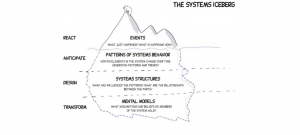![]()
The challenges government is tasked with solving have always been messy. With the explosion of big data and “smart” technologies, it seems to get messier every day. On the one hand, big data and new technologies are breaking down traditional government silos. But on the other hand, they have also illuminated the enormous complexity of already difficult challenges like climate change, public safety and the opiod crisis, making them seem nearly impossible – or at the very least, overwhelming – to solve.
I have faced my fair share of seemingly unsolvable challenges like chronic unemployment, sea level rise, and urban blight during my years working with cities to design, finance and implement resilient infrastructure solutions. Perhaps the best example was from 2014, when my colleagues and I were asked to come up with a strategy to deal with the daily flooding in Miami Beach that was (and still is) occurring because of sea-level rise.
It was around that time that I was introduced to the theory of systems thinking as a way to solve problems and get stuff done. It changed not only the way I approached our work with the City of Miami Beach and with all of our other partner cities, but also the way I’ve approached nearly every challenge since.
So here we go, a systems thinking primer from a systems thinking user.
FIGHTING THE FIRE VS FIREPROOFING
“Systems thinking can be used to explain and understand everything from inventory changes in a supply chain, to populations of bacteria and their hosts, to the instability in Syria, to the seemingly irrational behavior of certain elected officials.”- Steve Vassallo, general partner at Foundation Capital.
Systems thinking is typically explained with the Iceberg Model (see below). We spend most of our time at the top, thinking about and responding to acute conditions, events, and failures. For the cities I work with, acute events are often the latest storm or the intersection where every day there is another car accident. But fighting fires doesn’t fireproof your hillside. To fireproof your hillside, you have to see the whole system – including the patterns, institutional structures and values that played a part in creating the problem – in order to solve it.

As defined, systems thinking is an approach to problem solving that attempts to balance holistic thinking and reductionist thinking. In practice, it means taking a step back. It means zooming out to ask better questions to understand how different systems interact so that you can design more impactful solutions. It means seeking out team members from different academic disciplines, and it means working with folks from different departments to solve problems together. It means breaking out of traditional silos and seeking out fresh perspectives.
POURING CHAMPAGNE ON TRAINS
Let’s start with some guidance from an expert:
Clipped from Rory Sutherland, “Life Lessons from an Ad-Man”, TED October 2009. (https://www.ted.com/talks/rory_sutherland_life_lessons_from_an_ad_man)
While a funny clip, the core message is significant. When it comes to problem solving, you can’t rely on one particular set of expertise or one single perspective – “improvement” or making something “better” can take many forms.
The easiest way to start utilizing a systems thinking is to ask better questions.
WAYS TO CATCH MICE
Framing the right question is generally the hardest part of any problem solving process. More often than not, we frame needs and risks too narrowly, and end up solving one problem only to create another. Conversely, when questions are too broad, they foster a lot of dialogue but not a lot of action. Simple questions, framed effectively, lead to better solutions. Instead of “how do we build a better mousetrap?” think: “what are all of our options for catching mice?”
Back to the example of my work with Miami Beach on sea level rise and chronic flooding. Asking, “How can Miami Beach become more resilient?” is too broad to be actionable. On the other hand, “How do we fortify our seawall?” is too narrow and may be missing other, more cost-effective opportunities (dunes, mangroves, other nature-based infrastructure) to achieve the same result.
In this example, a better question may be “Where are we losing money today because of sea level rise and flooding?” Changing the question has four benefits:
- Helps identify the relevant underlying problem. Focusing on pain points like current (not future) losses, helps identify the relevant problem, not just the one that you have the mandate or authority to solve.
- Creates levers for collaboration across departments. Identifying opportunities for cities to reduce existing expenses can help different departments see common financial interest in a large project without creating internal conflicts and competition over resources.
- Opens doors to nontraditional funding/financing. Seeking to understand recurring financial losses associated with problems like sea level rise and flooding can lead to nontraditional funding/financing opportunities, like working with insurance or reinsurance firms or using resilience bonds.
- Focuses attention on the communities most affected by the problem. Perhaps most importantly, vulnerable communities are often where existing losses are greatest and most diffuse. It’s in these historically underserved communities where resilience investments can have a direct impact on people’s lives and livelihoods.
Before you start asking your colleagues better questions, you can ask yourself better questions too:
- Who is else is affected by the problem you’re trying to solve? (Think about: colleagues, citizens, community groups, local businesses, etc)
- Who will benefit if the problem is solved? (Think about: who stands to make money)
- What are all of the consequences of the problem? (Think about: social, economic, political)
- What government departments or agencies have authority over solving the problem? (Think about: others that may not have authority but have influence instead)
- Where is the problem occurring? (Think about: geographic boundaries, communities affected)
- Why is the problem occurring? (Think about: who or what is causing it)
Government employees are some of the most creative problem solvers around. Despite tight budgets, bureaucracy, regulation, and endless other challenges, government employees still deliver the services that make the places we live, work, play, invest, engage and learn better. Systems thinking will only serve to help you get started putting together a cadre of problem solvers and hone in on who else can help you address our messiest problems.
Want to read more about systems thinking? Check out this great piece written by Leyla Acaroglu or this excerpt from Steve Vassallo’s The Way to Design.
Elle Hempen is part of the GovLoop Featured Blogger program, where we feature blog posts by government voices from all across the country (and world!). To see more Featured Blogger posts, click here.


Leave a Reply
You must be logged in to post a comment.